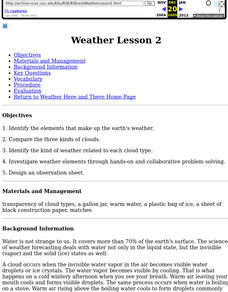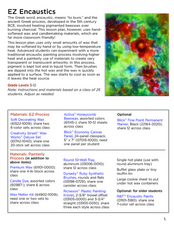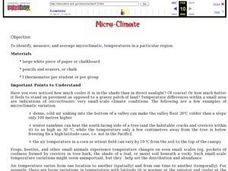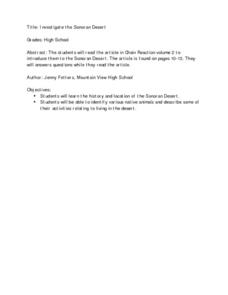Curated OER
The Water Cycle and Clementine
Third graders sing a piggyback song to explore the parts of the water cycle and then illustrate and label the water cycle in their science journals.
Curated OER
Greenhouse Design
Students work individually, or with partners, to develop a design for a
greenhouse, and calculate space requirements, equipment needed and cost of operation. They construct a scale model of the greenhouse.
Curated OER
Igneous Rock Formation
Fifth graders use the computer lab to search for answers to questions on their workshet. They discuss the creation of igneouss rocks and listen as the teacher lectures about lava. Students follow directions to mix a batch of salt dough...
Curated OER
Bill Nye-Wind
In this science worksheet, students look for the answers to the twelve questions related to the concept of wind and how it effects our environment.
Curated OER
Energy Detectives
Young scholars explore where energy comes from and identify the different kinds of energy. In this energy lesson students search their classroom for energy connections and record the way that they use energy.
Curated OER
Tree Inventory and Map Project
In this tree inventory and map project worksheet, students follow the directions on how to take inventories of trees and create a map from it. Students follow 4 sets of directions.
Texas State Energy Conservation Office
Unit 2 - Section 2 - Fuels for Everything
In this alternative energy worksheet, 6th graders read and study the varying types of fuel. Students read examples and ways that alternative fuel can be used.
Curated OER
Weather Lesson 2
Students identify the elements that make up the earth's weather. Begin by having students pretend they are hiking along a mountain ridge. It's been sunny and warm all day, but you see a dark line of clouds moving from the west.
Desert Discoveries
Lizard Dash!
Here is a terrific learning game that has pupils acting like lizards! Before the game starts, there is a class discussion on the differences between endotherms and exotherms. The main focus of the game is how each team must keep their...
Curated OER
Exploring How Rocks Are Formed
Students examine the three types of rocks. They discover the processes that occur so each type of rock can be formed. They participate in activities to help them see how rocks are formed.
Curated OER
Fusion Confusion
Students are introduced to three types of energy transfer: conduction, convection, and radiation. They model the scientific process of fusion to become with the sun and how it produces energy.
Curated OER
The Magma Also Rises
Convection is thoroughly demonstrated using a model of Earth's mantle. Detailed background information is provided for the teacher, as well as a list of materials. Although a colorful and detailed worksheet is available for the class,...
Curated OER
The Chemicals of Living Cells
Designed to be a study guide or self assessment for high school biologists, the worksheet has good questions about cell chemistry, but would need to be reformatted if you want your kids to write their answers on the paper. There are also...
Curated OER
EZ Encaustics
Have your class design a piece of art work using a canvas panel and wax. Learners employ a Greek process of art design popular in the fifth century to create their works. This is a great way to incorporate history into an art lesson.
Curated OER
Massif Mystery
After reviewing plate tectonic theories and the discovery of both the Atlantis Massif and the Lost City hydrothermal vents, earth science learners complete a worksheet and participate in discussions about what the types of rock found...
Curated OER
Cooler In The Shadows
Students investigate the concepts of shadows and how they are projected with objects different positions in relation to the sun. They conduct an experiment by observing objects in different positions. Then students record the observations.
Curated OER
Home-Made Clouds
Fourth graders witness cloud formation in a jar during a teacher lead simulation. They research, draw and predict weather using information they gather about clouds.
Science-Class.net
Rock Candy Crystals
Candy is one of my favorite words, and it's an even better word when it relates to science. Yes, candy science can happen when you grow rock candy crystals with your class. The entire process for growing these edible wonders of nature is...
Curated OER
Blast It! (Learning About Copper)
Opening with background information on copper use and mining, this worksheet assesses junior geologists' reading comprehension. A map activity is available, but the map is not. There is a useful set of vocabulary matching cards and a...
Curated OER
Rocking Rock Review
The three types of rocks are the focus of this earth science PowerPoint. Young scientists can review the composition of these types of rocks and see the ways they are formed. For example, sedimentary rocks are formed when tiny grains of...
Curated OER
Changes Written in Stone
Earth Rocks! Explore the many properties and types of rocks, where they come from and how they are formed. This resource presents a simplistic overview of the rock cycle. Tip: Bring in samples of sedimentary, metamorphic, and igneous...
Curated OER
Geologic Age
Students investigate radioactivity as a tool for measuring geologic time and how geologists use this information to determine the absolute age of rocks or minerals.
Curated OER
Micro-Climate
Atmosphere aces investigate the microclimates that exist within a larger area. They use a thermometer to record the varying temperatures and identify the microclimates on a map that they have drawn. This exercise helps them to understand...
Curated OER
Investigate the Sonoran Desert
Young scholars read article in Chain Reaction about the Sonoran Desert and answer questions.
Other popular searches
- Heating and Cooling Curves
- Science Heating and Cooling
- Heating and Cooling Curve
- Heating Cooling Curves
- Heating Cooling Curve
- Heating and Cooling Energy
- Heating and Cooling Systems
- Milk Heating and Cooling
- Heating and Cooling Water
- Cooling and Heating
- Heating Adan Cooling Curves
- Heating Adn Cooling Curves

























